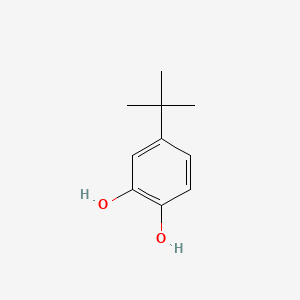D0747 | 4-tert-butylcatechol
| Toxicity | Dose | Time | Species | Model | Method | Action | Positive criterion | Reference |
|---|---|---|---|---|---|---|---|---|
| MEMBRANE POTENTIAL | 34.27±14.96 | human | qHTS-HepG2 | MMP assay | decrease | IC50 | 163 | |
| MEMBRANE POTENTIAL | 31.62 | human | HepG2 | MMP assay | decrease | IC50 | 163 | |
| MEMBRANE POTENTIAL | rat | hepatocytes | MMP assay | Negative | IC50 | 163 | ||
| Pictogram | Signal | Statements | Precautionary Statement Codes |
|---|---|---|---|
    |
Danger |
Aggregated GHS information provided by 2592 companies from 31 notifications to the ECHA C&L Inventory. Each notification may be associated with multiple companies. Reported as not meeting GHS hazard criteria by 27 of 2592 companies. For more detailed information, please visit ECHA C&L website Of the 30 notification(s) provided by 2565 of 2592 companies with hazard statement code(s): H302 (88.93%): Harmful if swallowed [Warning Acute toxicity, oral] H311 (18.64%): Toxic in contact with skin [Danger Acute toxicity, dermal] H312 (88.89%): Harmful in contact with skin [Warning Acute toxicity, dermal] H314 (99.84%): Causes severe skin burns and eye damage [Danger Skin corrosion/irritation] H317 (32.01%): May cause an allergic skin reaction [Warning Sensitization, Skin] H318 (12.44%): Causes serious eye damage [Danger Serious eye damage/eye irritation] H400 (10.18%): Very toxic to aquatic life [Warning Hazardous to the aquatic environment, acute hazard] H411 (94.66%): Toxic to aquatic life with long lasting effects [Hazardous to the aquatic environment, long-term hazard] Information may vary between notifications depending on impurities, additives, and other factors. The percentage value in parenthesis indicates the notified classification ratio from companies that provide hazard codes. Only hazard codes with percentage values above 10% are shown. |
P260, P261, P264, P270, P272, P273, P280, P301+P312, P301+P330+P331, P302+P352, P303+P361+P353, P304+P340, P305+P351+P338, P310, P312, P321, P322, P330, P333+P313, P361, P363, P391, P405, and P501; (The corresponding statement to each P-code can be found at the GHS Classification page.) |
  |
Danger |
H311: Toxic in contact with skin [Danger Acute toxicity, dermal] H351: Suspected of causing cancer [Warning Carcinogenicity] |
P201, P202, P280, P281, P302+P352, P308+P313, P312, P322, P361, P363, P405, and P501; (The corresponding statement to each P-code can be found at the GHS Classification page.) |
| 1, 4-(1,1-dimethylethyl)- | 1,2-Benzenediol, 4-(1,1-dimethylethyl)- | 1,2-Dihydroxy-4-tert-butylbenzene |
| 4- t-Butylcatechol | 4-(1,1-Dimethylethyl)-1,2-benzenediol | 4-(1,1-Dimethylethyl)-1,2-benzenediol |
| 4-(1,1-Dimethylethyl)catechol | 4-(tert-butyl)-pyrocatechol | 4-(tert-butyl)benzene-1,2-diol |
| 4-(tert-butyl)pyrocatechol | 4-(tertbutyl)-pyrocatechol | 4-06-00-06014 (Beilstein Handbook Reference) |
| 4-T-BUTYLCATECHOL | 4-TBC | 4-t-Butyl-1,2-benzenediol |
| 4-t-Butylpyrocatechol | 4-tert-Butyl-1,2-benzenediol | 4-tert-Butyl-1,2-dihydroxybenzene |
| 4-tert-Butyl-pyrocatechol | 4-tert-Butylcatechin | 4-tert-Butylcatechol |
| 4-tert-Butylcatechol (CAS 98-29-3) | 4-tert-Butylcatechol solution, >=98% (calc. to the dried substance, GC), liquid | 4-tert-Butylcatechol, 99% |
| 4-tert-Butylcatechol, >=98.0% (HPLC) | 4-tert-Butylcatechol, >=99.0% | 4-tert-Butylcatechol, SAJ first grade, >=98.0% |
| 4-tert-Butylcatechol, technical, flakes, >=98% (HPLC) | 4-tert-Butylpyrocatechol | 4-tert-Butylpyrocatechol |
| 4-tert-Butylpyrokatechin | 4-tert-Butylpyrokatechin [Czech] | 4-tert-butyl catechol |
| 4-tert-butylbenzene-1,2-diol | 4-tert-butylcathechol | 4-tert.-butyl pyrocatechol |
| 4-tert.-butyl-catechol | 4-tertbutylcatechol | 4-tertiarybutyl catechol |
| 4k7o | 98-29-3 | 9A069144KR |
| AB1009503 | AC-10567 | ACMC-209s9z |
| ACT03279 | AI3-24363 | AK-48632 |
| AKOS000119685 | ANW-40917 | B0739 |
| BBL011511 | BIDD:ER0238 | BP-30171 |
| BRN 2043335 | CAS-98-29-3 | CCRIS 3332 |
| CHEMBL220845 | CS-W017861 | CTK3I6918 |
| DB-057718 | DSSTox_CID_4687 | DSSTox_GSID_24687 |
| DSSTox_RID_77499 | DTXSID5024687 | EC 202-653-9 |
| EINECS 202-653-9 | EKZ; | F1995-0233 |
| FT-0082784 | FT-0619505 | FT-0703873 |
| InChI=1/C10H14O2/c1-10(2,3)7-4-5-8(11)9(12)6-7/h4-6,11-12H,1-3H | K765 | KS-00000JSQ |
| KSC486S1R | LS-2042 | MCULE-6988116335 |
| MFCD00002201 | MLS001065578 | NCGC00091483-01 |
| NCGC00091483-02 | NCGC00091483-03 | NCGC00091483-04 |
| NCGC00091483-05 | NCGC00260534-01 | NE10153 |
| NSC 5310 | NSC-5310 | NSC5310 |
| PubChem14587 | Pyrocatechol, 4-tert-butyl- | Q-200510 |
| Q-200511 | Q840843 | RTR-030676 |
| SBB061378 | SC-22458 | SCHEMBL50705 |
| SMR000568493 | ST2411038 | ST50824899 |
| STL146627 | Synox TBC | TBC |
| TR-030676 | TRA0068164 | Tox21_202989 |
| Tox21_400003 | UNII-06J124VX0O component XESZUVZBAMCAEJ-UHFFFAOYSA-N | UNII-9A069144KR |
| VS-02966 | WLN: QR BQ DX1 & 1 & 1 | XESZUVZBAMCAEJ-UHFFFAOYSA-N |
| Z1262246171 | ZINC388150 | diallyl butanedioate |
| p-t-Butylpyrocatechol | p-t-butyl catechol | p-tert-Butyl catechol |
| p-tert-Butylcatechol | p-tert-Butylpyrocatechol | p-tert.-butylcatechol |
| p-tertbutylcatechol | para-tert-butyl catechol | t-Butyl catechol |
| CAS Number | 105-09-9, 27213-78-1, 5472-03-7, 98-29-3 |
| PubChem Compound | 7381 |

